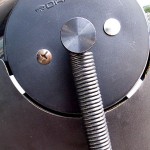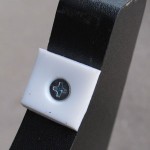A telescope needs to move smoothly, without any binding or sticking. The elegantly simple bearing design used in dobsonian telescopes uses a smooth surface riding on a small pad of some low friction material. This requires a pad of some material that slides smoothly and does not stick, to provide the motion. The standard answer of telescope builders is polytetrafluoroethylene, simply referred to by the acronym PTFE or the trade name Teflon.

The price is excellent for an 8-inch telescope, but there is some sign of cost cutting in the more recent versions. One interesting difference I found in this ‘scope was the bearing material. The bearing pads that are supplied do not appear to be PTFE, but instead a much harder material, possibly HDPE instead, which would be cheaper than PTFE. replacing these with PTFE results in a nice improvement in the smoothness and ease of movement of the telescope.
This particular telescope was missing two bearing pads, so some replacement was required, whatever the material. Without access to the original parts it was necessary to obtain whatever material was available, and that would be PTFE. Since it came in a different thickness than the original bearing it was also necessary to replace all four pads.

In place of the original staples, a small flat head screw is used to secure the Teflon in place. The soft material is easy to work. As long as the tools are sharp drilling and countersinking the pieces is easy. Best use a new drill bit if you have one, or grab one of the odd sizes that never seem to be used.
Position of the bearing around the radius of the trunnion have some impact into how easily the telescope will move. Positioned closer together and closer to the bottom of the bearing and the telescope will move more easily. Positions further part and higher on the bearing sides will result in more friction as the trunnion presses outwards against the pads.
The repair worked quite nicely, with a ‘scope that move smoothly across the sky. A bit more cleaning and a few minutes collimating the optics had the small telescope again ready for the sky.
